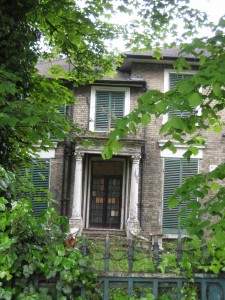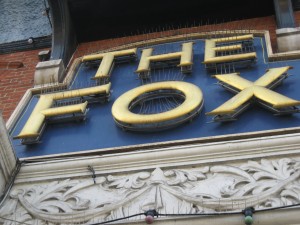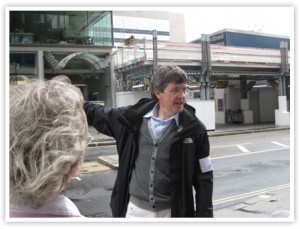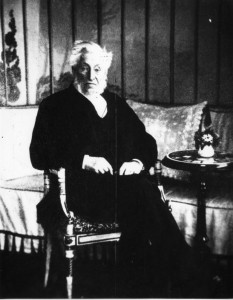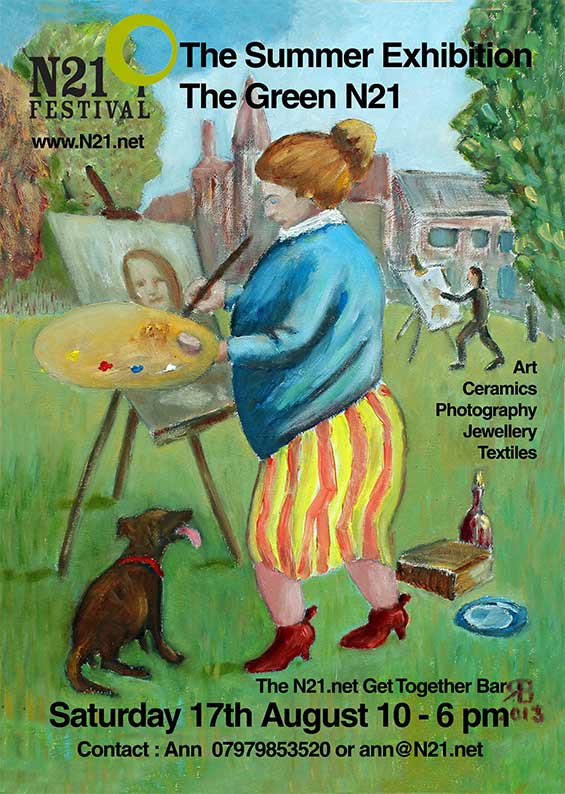And so, we have made it to 2014. The New Year lies before us, full of unknown things and hopeful resolutions.
But before we move on proper, one last look at some of the things we covered on this website in 2013, including one or two stories you might have missed…
January
2013 kicked off with Betty Wright nee Walton’s amazing story of how she and her brothers and sisters grew up in Southgate Town Hall in the years leading up to and including the war – her father had been a fire officer and the Councils official mace bearer. Sadly letters to local councillors and Mayor Anwar suggesting that Enfield Council open the Town Hall to local people one last time before the developers moved in, and in particular to enable Betty and her family to see the place where she was born, were simply ignored.
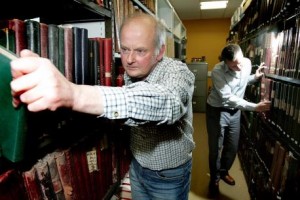
We heard the tale of Dr Alex Comfort, writer of the Joy of Sex and expert on ageing, who also grew up in Palmers Green, and lost fingers in a childhood experiment with fireworks. Sadly, we also learned of the death of much loved local author, historian and Enfield Archivist Graham Dalling, who once worked in the Town Hall.
Myddleton Road apparently became flesh and started tweeting about its unloved state and Enfield Council put on display a rare Constable drawing from its archives.
We discussed the origins of the word Broomfield, only to learn of news that another bid for funding for restoration of the house had failed, though some of the feedback was promising and hopes remained that a way forward could be found.
February
Space Art Gallery, a pop up venue on Southgate High Street, opened its second exhibition with work by Polish artist Maciej Hoffman. Wood Green’s Banksy was chipped and shipped to a US auction house, then withdrawn from sale at the 11th hour after a vociferous campaign, only to be put up for auction again later in the year. New artwork appeared in its stead, and in proof that you couldn’t make it up, we heard Poundland declare that they were fans of Banksy’s. Who knew? In the local corridors of power (also known as Enfield Council), Bush Hill Tory Councillor Chris Joannides hit the national press after being suspended from the party for making inappropriate remarks on Facebook.
There was news that PG could become better connected (though there could be disruption ahead for our neighbours in the south) – London First published its report on Cross Rail 2, this time linking North to South, and calling at Ally Pally. Still on transport, the third exhibition at Space Art Gallery featured 100 paintings of London Underground stations by Ross Ashmore. Broomfield Community Orchard embarked enthusiastically on the ancient ritual of wassailing.
March
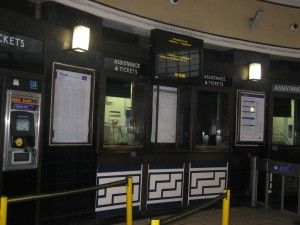 Southgate underground station celebrated its 80th birthday and we looked at the story of its opening. We also learned about a wartime horsemeat scandal at Southgate Town Hall. A new local debating group was formed, and we heard Chas and Dave sing the praises of the long gone Empire in Edmonton. (There is a rumour that Chas and Dave first met in Palmers Green – does anyone know if it’s true?). There were long queues outside Palmers Green’s flagship branch of Laiki bank, as Greece announced a bank levy, but relief as it was later announced that UK customers would mostly be exempt.
Southgate underground station celebrated its 80th birthday and we looked at the story of its opening. We also learned about a wartime horsemeat scandal at Southgate Town Hall. A new local debating group was formed, and we heard Chas and Dave sing the praises of the long gone Empire in Edmonton. (There is a rumour that Chas and Dave first met in Palmers Green – does anyone know if it’s true?). There were long queues outside Palmers Green’s flagship branch of Laiki bank, as Greece announced a bank levy, but relief as it was later announced that UK customers would mostly be exempt.
April
An anarchist cell was discovered taking direct action in Winchmore Hill. We learned a little more about the mysterious history of Truro House, and rare footage was discovered of a carnival in Palmers Green in 1931. We also found out, as if we didn’t already have an inkling, that PG is one of the busiest stations on First Capital Connect’s Great Northern Route.
Palmers Green residents were distraught to be deprived of their burger fix when local Scottish brasserie MacDonald’s was closed for a number of days.
May
May saw the launch of a new website bringing together local community groups, news and activities for the whole area. Designed and managed by webmaster Basil Clarke, Palmers Green Community is an excellent source of news about local groups and issues, and includes a forum and an excellent ‘what’s on’ section. It’s a brilliant addition to Palmers Green life – please sign up and get involved!
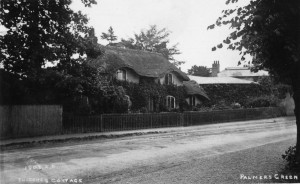
The Centenary Festival, a great programme and the kind weather brought thousands to Grovelands Park to celebrate over two days. We uncovered the story of a past Palmers Green tourist attraction – the flower bedecked Thatched House that once stood on the site of Westlakes and was famed for miles around.
June
Cameras were rolling again in June as the BBC made a pilot episode of a new drama called Family. Locations included the Fox and a house in Selbourne Road. Our neighbouring site Bowes and Bounds Connected told an amazing tale of the kinky cobbler of Myddleton Road, one of my favourite posts of the year.
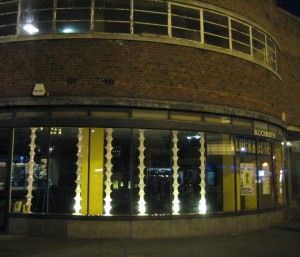
Open Studios weekend saw the Creative Network team get last minute access to the old Blockbusters building in Southgate and use it to stunning effect. This year, thanks to an Arts Council grant, the weekend also included a number of free workshops, alongside the opportunity to view work by over 30 artists, designers and crafts people. A second craft fair in November was packed out and full of excellent work.
July
In July a few lucky ticket holders got an opportunity to travel the whole of the Piccadilly Line from Cockfosters to Edgware on a 1938 vintage train as part of London Underground’s 150th anniversary celebrations. By then we were in the grip of a summer heat wave, but learned that it was far from as hot as PG has ever got according to voodooskies.com. In August 2003, the temperature reached 100 degrees. The coldest temperature recorded was just 17 degrees on January 12, 1987.
Enfield Council consulted on plans to ‘open up the park’ and build a new school on an unused Thames Water site adjacent to Grovelands park, splitting opinion in the area, given the love of the park and the desperate need for school places in the area. Meanwhile Alexandra Park celebrated its 150th birthday.

We investigated Palmers Green’s strong connections with the suffragettes and the Pankhurst family, including a riot in Palmers Green Triangle. Good thing then that July also saw news that spitting would be banned across Enfield.
Finally, an excellent film was launched to promote the restoration of Broomfield House. Created directed and produced by Christine Lalla, the film celebrates Broomfield’s unique history and heritage in the words of local people. If you haven’t seen it yet, you really should.
August
August saw our neighbours in Winchmore Hill out on the Green again for the Summer Art Exhibition including work by some of the area’s most interesting artists, photographers, sculptors, ceramicists and jewellers. There was a UFO sighting in Enfield and we explored the story of how one man’s unofficial green belt policy shaped the future of Palmers Green
September
September’s Palmers Green Festival in Broomfield Park was the biggest and best for many years, and the park was positively buzzing. The Palmers Green Tales project – recording memories of local residents – was launched at Ruth Winston House as part of the festival, and Southgate Photographic society produced and excellent video showing how familiar views in PG had changed during the last 100 years. We also revisited the story of the Cuffley airship, and a world war one dog fight which was witnessed by thousands of people in North London’s skies.
October
And so the nights began to draw in. In October, a worrying PG betting shop shortage was averted with the news of the opening of another bookies; people danced in the streets. We investigated some of Enfield ghosts but found that although the borough has more than its fair share, PG itself just isn’t that spooky. Unless you know different.
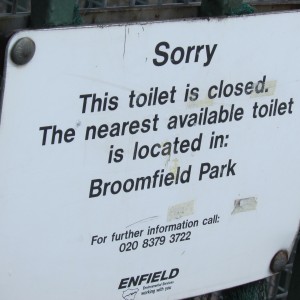 Joe Studman launched the first local history course for 30 years at the Dugdale Centre, accompanied by six themed walks. The course was so successful that it will run again in April – book your place now, it’s selling fast. Palmers Green Triangle’s underground toilets were sealed off and the clutter in the triangle removed though there is still no news about how long we will have to wait for more substantial improvements to the area and the reinstatement of our lost tree. We told the story of the terrible night in 1941 when the Princes Dance Hall was bombed with great loss of life. Betty Walton’s father was one of the first on the scene.
Joe Studman launched the first local history course for 30 years at the Dugdale Centre, accompanied by six themed walks. The course was so successful that it will run again in April – book your place now, it’s selling fast. Palmers Green Triangle’s underground toilets were sealed off and the clutter in the triangle removed though there is still no news about how long we will have to wait for more substantial improvements to the area and the reinstatement of our lost tree. We told the story of the terrible night in 1941 when the Princes Dance Hall was bombed with great loss of life. Betty Walton’s father was one of the first on the scene.
November
In November, the library was closed for the first part of the changes to the Town Hall area, and hoardings were put up around the Town Hall itself. But on the upside, we had our first real Christmas tree in many a year.
December
With the sad death of Nelson Mandela, we explored the role of Alexandra Park in the fight against apartheid. The BBC screened a follow up to the programme it filmed 10 years ago on the buildings at risk in London, including Broomfield House. And Palmers Green featured in an award winning feature film writtenby local lads Sam Bourke and Stefan Georgiou, Dead Cat, screened at Talkies Community Cinema.
On the subject of Talkies, it would have been difficult to mention all the great events that the Talkies team has run in the last 12 months; the programme has been varied and interesting and is becoming an indispensable part of PG’s social glue. As has Palmers Green Life, the new monthly magazine set up by Anthony Webb estate agents, featuring history, people, local groups and events. PG has needed something like this for years and now we have it.
Finally, a thanks to everyone who has been so kind about this website and the articles we have provided for Palmers Green Life. We had more than 10,000 individual visitors to the site this year, ad 34,000 ‘hits’ which is gobsmacking. I hope that you enjoyed what you read. If, perchance, you would like to contribute an article to the site, please do get in touch.
Here’s to a great 2014. Happy New Year!
